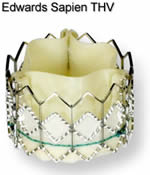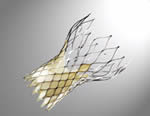Aortic valve stenosis is the commonest native valve disease in Europe (1). Treatment is indicated in severe aortic stenosis and when patients experience symptoms. Surgical replacement of the aortic valve by a mechanical or biological prosthesis performed under cardiopulmonary bypass has been the only practical therapeutic option available for these patients. This procedure has an acceptable operative mortality even in elderly patients and provides good long term results.
Nevertheless, patients with significant comorbidities or previous patent coronary artery bypass grafts are often denied surgery given the high operative risk and considerable mortality. This has been demonstrated in the Euro Heart Survey, where around 30% of patients with severe aortic valve disease and symptoms were not proposed to the surgeon.
Implantation of the Aortic Valve by Transcatheter Techniques
In 2002, Cribier et al reported the first case of percutaneous transcatheter implantation of an aortic valve prosthesis for aortic stenosis in man (2). This “salvage” procedure was initially reserved for companionate cases where the risk of death after conventional surgery was considered too important. It does not require cardiopulmonary bypass or aortic cross clamping and may be performed under locoregional anesthesia and sedation. As the name implies the prosthesis is “implanted” and does not “replace” the native valve. Since the first case, the technique has been employed in a number in centers within specific study protocols in certain indications. The procedure can be performed either by :
- a. retrograde transfemoral approach through the common femoral artery (often approached surgically)
- b. antegrade transapical approach through the apex of the left ventricle via an anterolateral thoracotomy
Two devices are currently available:
- 1. the Edwards-Sapien valve (Edwards Lifesciences Inc, California, USA) consists of 3 bovine pericardial leaflets mounted within a tubular stainless-steel stent (figure 1). It exists in 23 and 26mm sizes, and is available for both types of implantation. The valve is crimped just prior to implantation and then deployed by balloon expansion under rapid pacing of the heart.
- 2. the CoreValve Revalving System (CRS TM, CoreValve Inc, Irvine, California, USA), consists of 3 porcine pericardial leaflets mounted in a self-expanding nitinol stent (figure 2). It exists in 26 and 29mm sizes and is available for transfemoral implantation
Results
Results published in medical literature (3,4) of this technique include elderly patients contraindicated to surgery or at a considerably high risk or as expressed by elevated STS Predicted Risk of Mortality score or EuroScore. After careful selection of patients, procedural success is high (90% for the transapical approach). Adequate diameter of femoral and iliac vessels is a sine que non for the transfemoral approach. Congruity between aortic annulus (determined by preoperative work up) and size of available prosthesis is another determinant factor for both techniques.
In-hospital mortality at 30 days ranges from 5 to 18%. Valve area after implantation ranges from 1.5 to 1.8cm² and shows an adequately functional valve by echocardiographic studies 6-12 months after implantation. Embolic complications, namely stroke, have been reported to be lower in the transapical than the transfemoral approach. This is probably due to less catheter manipulation in the aortic arch. Access routes complications particularly with the transfemoral approach are another important source of complications (5).
Perspectives
Fields of progress include improvement in introducer and valve size as well as in the quality of the imaging technique, many of which are already in progress. Another interesting indication for this approach are patients with a degenerated bioprosthesis. Implantation of a transcatheter valve inside the previous bioprosthesis avoids the risk of redo surgery (6) and widen the horizons for early implantation of bioprosthesis should the procedure prove its efficacy, safety and “long term” reliability.
Figure 1. The Edwards-Sapien valve

Figure 2. The CoreValve percutaneous aortic valve

The content of this article reflects the personal opinion of the author/s and is not necessarily the official position of the European Society of Cardiology.


 Our mission: To reduce the burden of cardiovascular disease.
Our mission: To reduce the burden of cardiovascular disease.